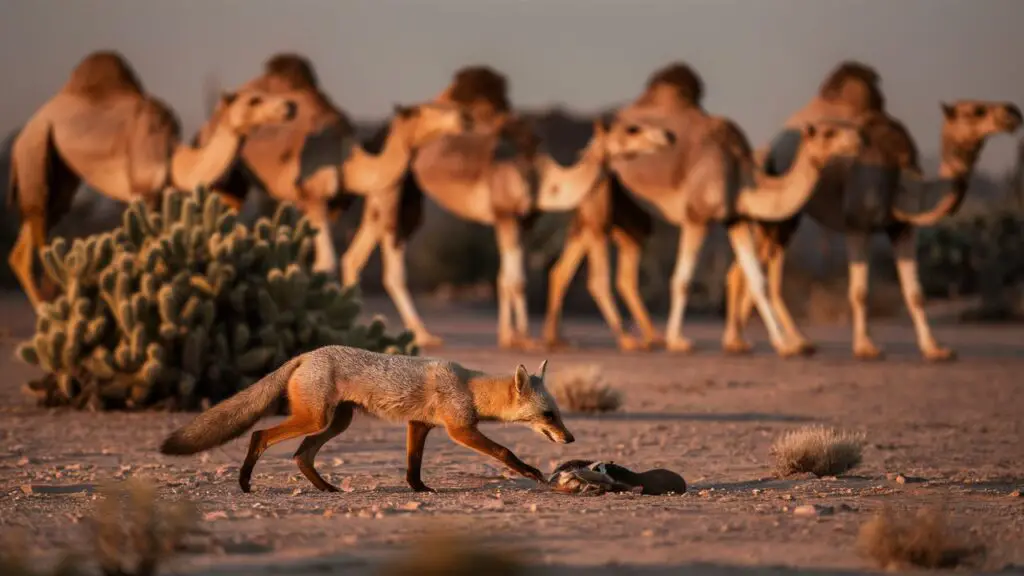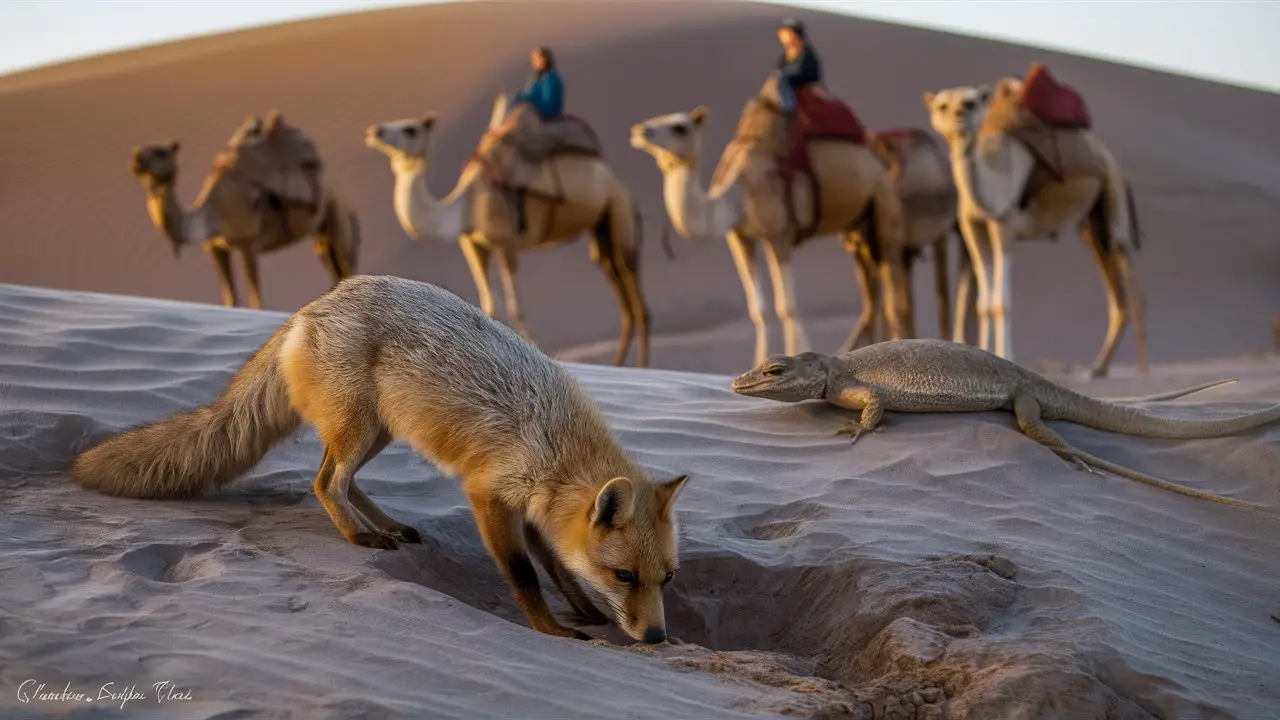As you explore the vast desert landscapes, you can’t help but wonder – how do animals survive in such harsh conditions? The successful desert dwellers have adapted in remarkable ways. To cope with extreme heat and lack of water, they’ve developed specialized physical traits, behaviors, and lifestyles. Their fascinating survival strategies enable them to not only endure, but thrive in arid environments. In this article, you’ll learn about the incredible adaptations that help everything from kangaroo rats to camels to Gila monsters live and prosper in desert habitats. Discover the natural ingenuity that allows clever creatures to make the most of sparse resources. Join us on an eye-opening journey into the secret world of desert survival.
Adaptations for Enduring Heat and Lack of Water
Physiological Adaptations
To survive extreme heat and lack of water, desert wildlife have developed several physiological adaptations. Their bodies are adapted for water retention and conservation. Many desert animals have specialized kidneys that can produce highly concentrated urine, reducing water loss. Some also have the ability to withstand dehydration without ill effects, surviving up to 25% loss of body water in some cases.
Behavioral Adaptations
Desert animals exhibit behavioral adaptations that help them endure the harsh climate. Many are nocturnal, sleeping during the hottest parts of the day and being active at night when temperatures are cooler. Burrows and dens also provide shelter and insulation. Desert animals tend to move less to avoid overheating and dehydration.
Dietary Adaptations
Desert animals have adapted their diets to their environment. Many get moisture from the plants and animals they eat. Succulents, cacti, and other desert plants are staples of their diets. Some desert animals also eat insects and lizards. The kangaroo rat, for example, obtains water metabolically through the oxidation of food and seeds it eats.
In summary, desert wildlife employ a variety of strategies to survive heat and lack of water. Physiological, behavioral, and dietary adaptations have evolved over time enabling these animals to endure and even thrive in hot, arid climates. Their specialized adaptations for water retention and conservation, sheltering from the elements, and obtaining moisture from food allow desert animals to survive where most creatures could not.
Finding Food and Water in the Desert
Foraging for scarce plant life
Desert wildlife must adapt to the harsh conditions by developing specialized methods for locating scarce food sources. Many animals forage for whatever limited plant life exists, such as cacti, grasses, shrubs, and bushes. The desert bighorn sheep, for example, feeds on a variety of desert grasses and shrubs. Similarly, the Gila monster consumes cacti, eggs, small mammals, and carrion.
Hunting prey
Other desert animals have evolved as skilled predators to hunt for prey. The coyote, an opportunistic predator, hunts small mammals like rabbits, rodents, birds, and reptiles. Similarly, the bobcat feeds on a variety of prey such as rabbits, hares, rodents, birds, and even deer.
Scavenging and carrion
Some desert wildlife resort to scavenging or feeding on carrion, the decaying flesh of dead animals. The turkey vulture, with its acute sense of smell, locates carrion and feeds on the remains of dead animals that would otherwise breed disease. Similarly, the kit fox is an opportunistic scavenger and feeds on carrion, insects, plants, and small prey.
Obtaining moisture
With limited and unpredictable rainfall, desert animals have adapted in innovative ways to obtain moisture. Many animals remain inactive during the day to conserve energy and emerge at night when temperatures drop. The kangaroo rat, for example, obtains moisture from the seeds and plants it consumes. Similarly, the camel can go for days without water by conserving moisture and living off the fat stored in its hump.
In summary, desert wildlife have developed highly specialized methods for locating scarce food and water sources as a means of adaptation to survive the harsh conditions. Their ability to forage, hunt, scavenge and obtain moisture allows them to thrive where others cannot.
Avoiding Predators Through Camouflage and Other Means
Camouflage
Desert wildlife have developed camouflage adaptations to avoid predation. Their fur or plumage often matches the coloration of the local environment, allowing them to blend into the landscape. For example, the fur of the Fennec fox, which inhabits the Sahara desert, is tan or light brown, similar to the color of sand. Its large ears also provide camouflage, as they resemble desert plants. Some species, like the Desert horned lizard, can change color to match the substrate.
Nocturnal Behavior
To avoid predators, many desert animals exhibit nocturnal behavior, being active primarily at night when temperatures are lower and predators are less active. For example, kit foxes, ringtail cats, and bobcats emerge from their dens at night to hunt for prey and forage for food under the cover of darkness. The pale coloring of species like the Great jerboa also provides camouflage in the moonlight. By day, these animals rest in burrows or sheltered areas to avoid the heat and hide from predators.
Defensive Strategies
Some desert wildlife employ defensive strategies to deter predators. For example, the Desert iguana and Desert horned lizard inflate their bodies to appear larger and more formidable. The Mojave rattlesnake and Western diamondback rattlesnake will coil and shake their rattle in warning. As a last resort, these snakes may strike in defense. Some species also secrete foul-tasting chemicals from their skin to repel predators. The Desert tortoise can completely withdraw its head and limbs into its shell for protection. Working together, camouflage, nocturnal behavior, and defensive strategies allow desert wildlife to avoid predators in their harsh, unforgiving environment.
Unique Social Structures and Behaviors
For desert wildlife to survive and thrive in such harsh, arid environments, unique social structures and behaviors have evolved as adaptations over time.
Complex social hierarchies
Many desert animals like meerkats, hyenas, and coyotes live in complex social groups with linear dominance hierarchies. These social structures reduce conflict within the group and ensure access to resources. The dominant animals get preferential access to food, shelter, and mates. However, they also have the responsibility to protect and provide for subordinate members of the group.
Division of labor
In some desert species like naked mole rats, there is a clear division of labor within the colony. Only one female breeds, while other members take on roles such as defending the colony, maintaining the nest, and foraging for food. This division of labor, along with the social suppression of breeding in subordinate females, helps the colony function efficiently with limited resources.
Resource sharing
Some desert animals, especially rodents like kangaroo rats, exhibit resource-sharing behaviors that improve the survival of all group members. Food that is collected by one animal is often shared, either voluntarily or due to pilfering by other group members. This food sharing, along with group foraging and alerting others to the location of resources, helps ensure that all members have access to enough food and water to survive.
Cooperative hunting
A few desert carnivores like African wild dogs and coyotes employ cooperative hunting techniques to secure prey, even in harsh conditions where resources are scarce. Hunting in coordinated packs is more successful than solitary hunting, and it allows these animals to take down large prey that provides food for the entire group. The social bonds formed during cooperative hunting also strengthen group cohesion.
As you can see, developing complex social behaviors and group structures is a key strategy that allows many desert animals to overcome challenges posed by extreme environments. Strong social ties, division of labor, resource sharing, and cooperative hunting have all evolved to help maximize survival and reproductive success, even when conditions are difficult.

Threats to Desert Wildlife Survival Strategies
Desert wildlife have developed highly specialized adaptations to survive and thrive in harsh, arid environments where resources are scarce. However, even with these specialized adaptations, desert animals face significant threats that challenge their survival.
Loss of Habitat
The degradation and fragmentation of habitat poses a serious threat to desert wildlife. As human populations expand into desert ecosystems, the land is developed for agricultural, residential and commercial use. This development destroys and fragments the habitat that desert animals rely on, isolating populations and restricting access to resources. Protecting large, contiguous expanses of desert habitat is critical for the long term survival of desert wildlife.
Climate Change
Desert ecosystems are finely tuned to the climate, with many desert animals relying on predictable patterns of temperature, rainfall and resource availability. However, the climate is changing rapidly due to human-caused global warming. Increasing temperatures, changes in weather patterns and the timing/intensity of seasonal events threaten to disrupt these patterns that desert wildlife depend on. Some species may be able to adapt to these changes over time through evolution, but the rapid pace of current climate change poses a severe challenge.
Poaching and Hunting
Some desert animals, particularly large carnivores, are targeted by poachers and hunters. Animals like cheetahs, leopards and certain bird of prey species are illegally killed for their fur, or in retaliation for preying on livestock. Unregulated hunting and poaching have decimated populations of some desert animals and continue to threaten vulnerable species. Enforcing anti-poaching laws and regulating hunting are necessary to curb these threats.
In summary, loss and fragmentation of habitat, climate change, poaching and unregulated hunting represent significant threats to desert wildlife survival strategies. Protecting habitat, mitigating and adapting to climate change, and enforcing laws against poaching and overhunting are critical actions needed to help ensure the long term survival of desert animals. By addressing these threats, we can work to maintain healthy populations of desert wildlife for generations to come.
Conclusion
As we have seen, the desert is an extreme environment that poses intense challenges for the plants and animals that call it home. Yet over time, evolution has equipped its inhabitants with ingenious adaptations that enable their survival. From the cactus’ moisture-trapping ribs and spines to the kangaroo rat’s efficient kidneys and concentrated urine, desert dwellers have developed specialized traits and behaviors to overcome scarce water and food, extreme temperatures, and shifting sands. By understanding these survival strategies, you gain deeper appreciation for the remarkable diversity and resilience of life even in Earth’s harshest habitats. We must continue studying these perfectly-tuned organisms to uncover more of nature’s secrets, inspire biomimetic innovations, and inform conservation of fragile desert ecosystems.
Don’t Miss a Thing! Enhance Your Wildlife Photography with Ultra-X Night Vision Goggles.
GET NOW!






